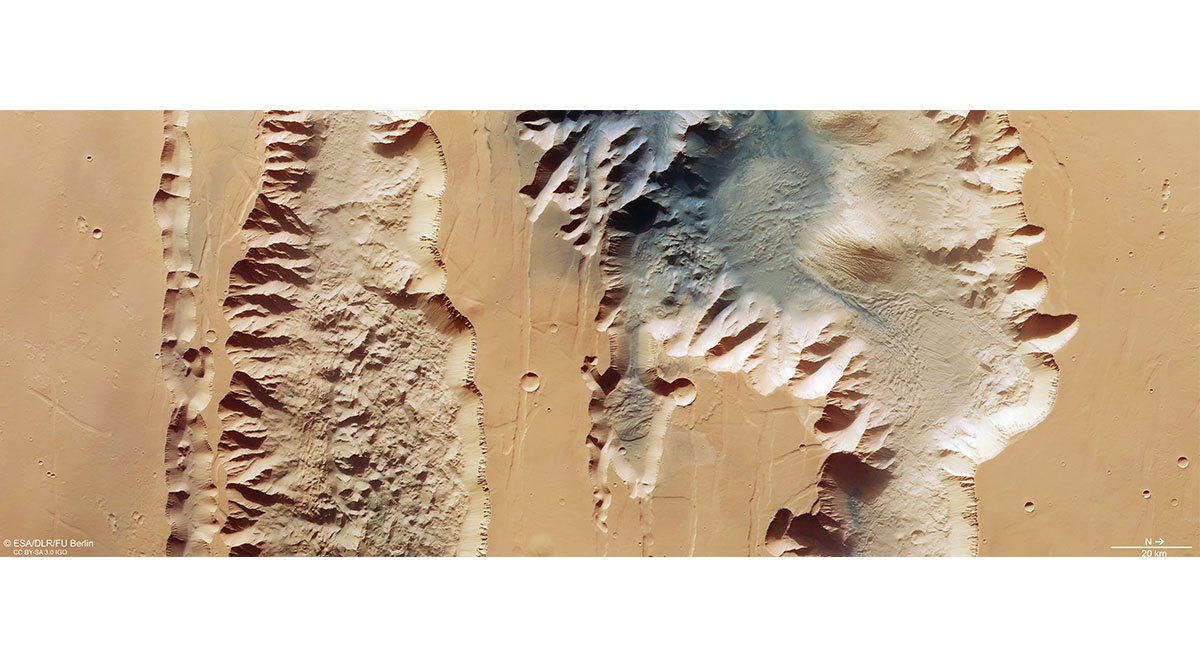
The European Space Agency’s (ESA) Mars Express probe has captured images of the Valles Marineris, which is the largest canyon system in the Solar System. Valles Marineris is almost ten times longer, twenty times wider and five times deeper than the Grand Canyon. To put that into perspective, it spans a distance larger than that between Kashmir and Kanyakumari.
Its 4000-kilometre length, 200-kilometre width and depth of up to 7 kilometres is not the only thing that makes Valles Marineris different from the Grand Canyon. The terrestrial canyon was formed when the Colorado River eroded away rock while Valles Marineris is believed to have been formed through the drifting apart of tectonic plates.
The image taken by Mars Express shows the two trenches (or chasma) that form part of the western region of Valles Marineris. On the left, which is south in the image, is the 840-kilometre-long lus Chasma and on the right is the 805-kilometre-long Tithonium Chasma. While the high-resolution image shows incredible surface detail, a topographic map reveals how incredibly deep the chasmata are: as deep as 7 kilometres.
A patch of dark sand at the top of Tithonium Chasma brings colour contrast to the image. Scientists believe this sand may have come from the nearby Tharsis volcanic region. Neighbouring the dark sand dunes are two light-toned mounds, one of which is cut in half by the top border of the image.
Subscriber Only Stories
These mounds are actually mountains rising more than 3,000 metres. Martian winds have strongly eroded their surface, suggesting that they are made of a weaker material than the rock that surrounds them.
The space between the two mounds is marked by a series of smaller bumps. Investigations by Mars Express have discovered water-bearing sulphate minerals in the region. One theory suggests that the chasma may have been filled by liquid, and the bumps were formed by the evaporation of this liquid. But this theory is heavily contested.
On the lower right of the mount, there are parallel lines and debris piles that indicate a recent landslide. This landslide was caused by the collapse of the canyon wall on the right and is likely to have occurred recently since it has not been eroded strongly.
The lus Chasma also has a bunch of fascinating features. The pulling apart of tectonic plates that created the chasma also appears to have caused jagged triangular formations of rock that look like a row of shark teeth. These rock formations have collapsed and have been eroded over time.
https://news.google.com/__i/rss/rd/articles/CBMibGh0dHBzOi8vaW5kaWFuZXhwcmVzcy5jb20vYXJ0aWNsZS90ZWNobm9sb2d5L3NjaWVuY2UvZXNhLW1hcnMtZXhwcmVzcy12YWxsZXMtbWFyaW5lcmlzLWdyYW5kLWNhbnlvbi04MDUyMDI5L9IBAA?oc=5
2022-07-26 07:16:39Z
1507910376
Tidak ada komentar:
Posting Komentar